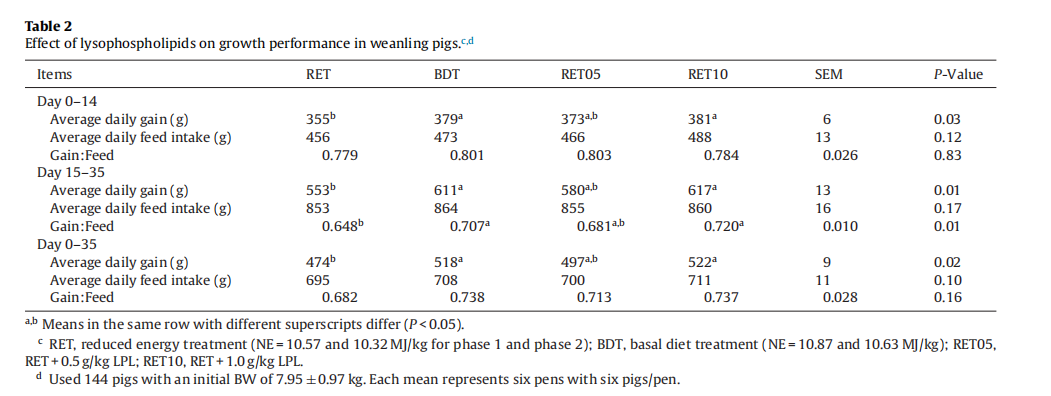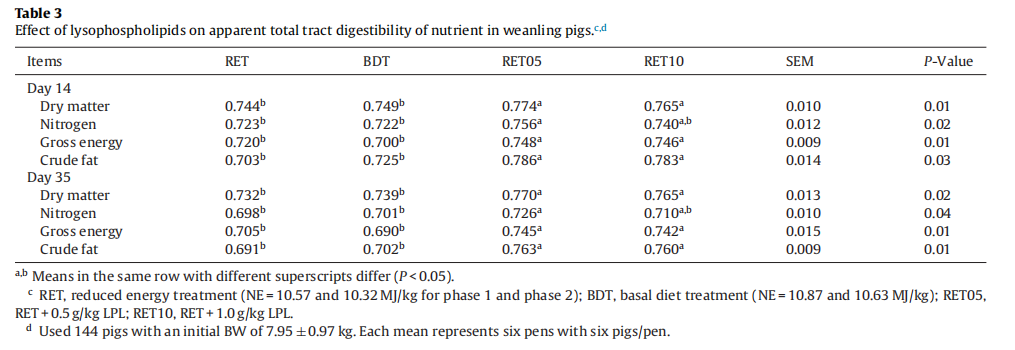
The result is written at the beginning
1. In the low-energy treatment group, adding 1.0g/kg lysophosphatidylcholine significantly increased the average daily weight gain (ADG) of weaned piglets (p<0.05).
2. In the low-energy treatment group and the basic feed treatment group, adding 0.5g/kg and 1.0g/kg lysophosphatidylcholine significantly increased the apparent total digestibility (ATTD) of dry matter, total energy, and crude fat in weaned piglets (p<0.05); The apparent total digestibility of nitrogen (ATTD) was higher in the low-energy treatment group when 0.5g/Kg lysophosphatidylcholine was added compared to the other groups (p<0.05).
3. The low-energy treatment group and the basic feed treatment group were treated with 0.5g/kg and 1.0g/kg lysophosphatidylcholine added to the low-energy treatment group, which significantly reduced the triglyceride concentration in the serum of weaned piglets (p<0.05).
When feeding low-energy feed to weaned piglets, the addition of lysophosphatidylLPL increased the average daily weight gain (ADG) and nutrient digestibility of weaned piglets, while reducing serum triglyceride concentration.
Experimental grouping
144 weaned piglets with an average weight of 7.95 ± 0.97 kg were randomly assigned to four treatment groups for a 35 day experiment. The experiment is divided into two stages, with different levels of net energy (NE), including the first stage (days 0-14) and the second stage (days 15-35). Processing includes:
⑴ RET: Low energy treatment (first stage NE=10.57MJ/kg, second stage NE=10.32MJ/kg);
⑵BDT: Basic feed processing (NE=10.87MJ/kg and 10.63 MJ/kg);
⑶RET05:RET+0.5g/KgLPL;
⑷RET10:RET+1.0g/kgLPL。
Test data



Discuss:
Growth performance: In this study, the addition of 1.0g/kgLPL to the feed resulted in improved ADG at 0-14, 15-35, and 0-35 days, and an improved feed to meat ratio at 15-35 days. The positive impact on growth performance may be that adding LPL to the feed increases palatability, thereby increasing feed and energy intake. The hydrophilic part of emulsifier molecules dissolves in water, while the hydrophobic part dissolves in oil droplets. Therefore, emulsifiers can maintain the distribution of oil droplets in emulsions, which is beneficial for the digestion and absorption of lipids. Lysophospholipid (LPL) is considered an emulsifier that helps improve lipid digestion in weaned piglets. Previous researchers have added it to pig feed with the aim of improving lipid digestibility and enhancing pig growth performance.
Nutrient digestibility: Jones et al. (1992) found that adding lecithin or LPL to the diet of weaned piglets can improve the digestibility of lard. Jin et al. (1998) added lecithin to the diet of weaned piglets, which also demonstrated an improvement in the digestibility of lard. In our study, pigs fed LPL feed showed an increase in DM, GE, and crude fat ATTD in the first two and last three weeks after weaning. This is consistent with the research results of Jin et al. (1998), who reported that adding lecithin to lard feed can increase the ATTD of DM, GE, and N in weaned pigs. Similar results were found when LPL was provided to growing pigs (Dierick and Decuypere, 2004). In summary, the increase in fat digestibility in our study may contribute to the increase of DM, GE, and N ATTD.
Blood indicators: There are relatively few reports on the effects of emulsifiers on pig blood indicators. Jones et al. (1992) reported that the blood triglyceride levels of weaned piglets fed with fat emulsifiers (phospholipids or lysophosphatidylcholine) were lower than those fed with fat without emulsifiers. This is consistent with the results of this study, which showed that the triglyceride levels of pigs fed with LPL were lower than those fed with feed without LPL. In addition, De Rodas et al. (1995) observed that when emulsifiers (0.1% or 0.02% lecithin) were added to the feed of weaned piglets, serum triglyceride levels tended to decrease. Poultry also have similar results. In this study, the addition of 0.05% and 0.10% LPL had no effect on low-density lipoprotein cholesterol. The mechanism by which emulsifiers affect triglycerides or cholesterol is still unclear. In summary, we can assume that in the later stage after weaning, the addition of emulsifiers can reduce triglycerides, but its effect on cholesterol may depend on the source of fat and the type of emulsifier.
Conclusion:
Adding LPL can improve the average daily weight gain (ADG) of weaned piglets fed a reduced energy diet. In this study, the addition of LPL increased the apparent digestibility ATTD of dry matter, nitrogen, total energy, and crude fat, and reduced the serum triglyceride concentration in weaned piglets.
The original:Effect of emulsifier (lysophospholipids) on growth performance, nutrient digestibility and blood profile in weanling pigs
Original author:Zhao P Y, Li H L, Hossain M M, et al.
Note: Reproduction is only for sharing and for the purpose of learning and communication. If there is any infringement, please contact us for deletion.